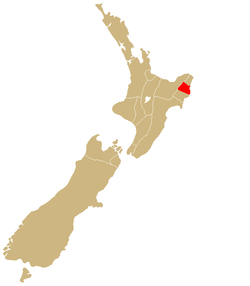Top Qs
Timeline
Chat
Perspective
Te Aitanga-a-Hauiti
Māori iwi in New Zealand From Wikipedia, the free encyclopedia
Remove ads
Te Aitanga-a-Hauiti is a Māori iwi (tribe) on the East Coast of New Zealand's North Island. Its rohe (tribal area) covers the area from Tawhiti-a-Paoa Tokomaru Bay to Te Toka-a-Taiau Gisborne on the East Coast of the North Island of New Zealand.[1][2]
Te Aitanga-a-Hauiti comprises over fifty hapu: from Te Whanau-a-Te Aotawarirangi the northern hapu Tokomaru Bay to Ngati Oneone the southern hapu Gisborne. Many can trace their whakapapa (ancestry) back to Takitimu and Horouta waka (migration canoes) that arrived in Tairawhiti, and back to the famous ancestor Paikea. However, Te Aitanga-a-Hauiti trace their whakapapa from Rongomaituaho, grandson of Uenuku and son of Kahutiaterangi, who captained the Tereanini waka.[1][2]
Remove ads
History
Summarize
Perspective
Early history

About the 16th century, following major political and social upheavals between the three brothers Taua-Ariki, Mahaki-Ewe-Karoro and Hauiti, Hauiti eventually stamped his mana over Uawa (Tolaga Bay) as it is known to many local inhabitants; hence the title of the major tribal group in this area Te Aitanga-a-Hauiti, meaning the descendants of Hauiti.[1][2]
Local hapu and the Hauiti ariki Whakatataare-o-te-rangi encountered the British explorer Captain James Cook in 1769; including Tupaia the Tahitian who accompanied Cook on his voyage around the Pacific Ocean.[1][2] According to tribal tradition, Hauiti ariki Te Kani-a-Takirau was offered in 1854 the Kingite Crown, but he declined the offer.[3]
Modern history
One of Te Aitanga a Hauiti's more famous modern marae (meeting places) steeped in Māori history is Te Poho-o-Rawiri of Ngati Oneone situated in Gisborne. The origins of Rongowhakaata, the eponymous ancestor, is traced to the area occupied by Te Aitanga-a-Hauiti. Hauiti married the daughter of Rongowhakaata named Kahukura-iti.
Titirangi Maunga is the tribe's maunga (revered mountain), holds a similar name as Titirangi Maunga (Kaiti Hill) in Gisborne. Uawa-nui-a-Ruamatua, dividing the township Tolaga Bay and Hauiti, is the tribe's awa (sacred river).[1][2]
Remove ads
Notable people
Notable members of the tribe include:
- Parekura Horomia – politician
- Robyn Kahukiwa – artist
- Harry Ngata – association footballer
- Tūtekohi Rangi (died 1956) – tohunga and faith healer
- Waimarama Taumaunu – netballer
- John Walsh – artist
See also
References
Wikiwand - on
Seamless Wikipedia browsing. On steroids.
Remove ads

